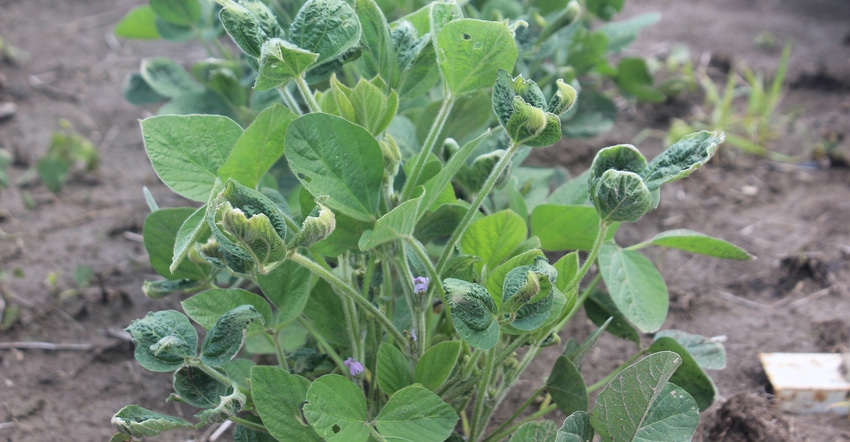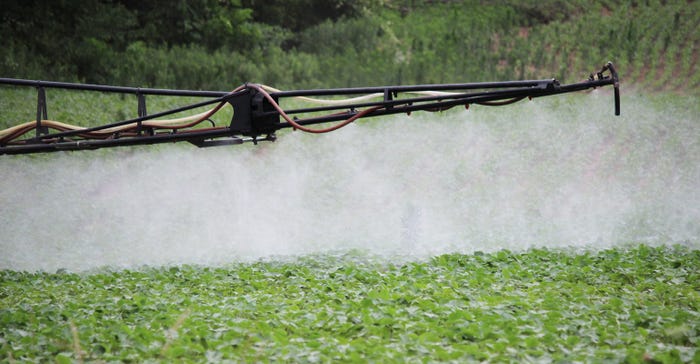July 2, 2018

By Jill Loehr
The 2018 growing season feels like déjà vu, says Jean Payne, Illinois Chemical and Fertilizer Association president, as farmers and applicators watch soybeans cup and pesticide misuse claims multiply from off-target dicamba movement.
University of Illinois weed scientist Aaron Hager says he walked an off-target dicamba soybean field on June 6, about two weeks earlier than in 2017, and estimates 150,000 impacted acres as of the third week in June.
According to Payne, the Illinois Department of Agriculture has received 66 formal complaints related to dicamba. “Most are generated from central Illinois at this time,” she says, adding that the department continues to take many injury-related calls.
“The phone calls I’ve received from retailers are those of disbelief coupled with frustration,” Payne says. “They felt they had the surrounding fields mapped, they knew where the sensitive crops and areas were, they applied on days when the winds were within label and blowing away from those areas, and they were extremely cautious.”
There were several days with low wind speeds in early June that were conducive for on-label applications, Payne says. “A lot of commercial and private applicators feel they were on-label.”
Hager says with millions of sensitive soybean acres in Illinois, off-target dicamba movement is nearly impossible to avoid.
“It’s always been that way and always will be that way. No amount of training will change that,” he says. “There are many ways soybeans can be exposed to dicamba, and none of the training addressed the possibility of off-target movement due to volatility — and that’s a real cause.”

IN-SEASON DICAMBA BEYOND 2018? The Engenia herbicide label expires Dec. 20, and XtendiMax and FeXapan labels expire Nov. 11. IFCA’s Jean Payne says the EPA indicated it would decide whether to renew the labels by the end of August. “There’s a lot at stake here.”

Payne says several retail applicators added injection units to sprayers and used dedicated blending systems after the contamination issues in 2017.
“When applicators still see symptomology, and not just a little but an entire field, it makes no sense, because we know it wasn’t contamination,” Payne says. “It goes back to the question of ‘What is it?’”
The off-target movement patterns paint a clear picture.
“I don’t know how you have cupping uniformity on a 120-acre field that results from anything else besides volatility,” Hager says. “You can’t get that with contaminated equipment.”
Next steps
What should farmers do if they find cupped soybeans? Reach out to your commercial or private applicator and your chemical representative, Payne says, and file a pesticide misuse complaint with IDOA. A formal complaint is one way to “position” yourself to be compensated for yield loss if insurance comes into play.
“If the IDOA investigation does find an applicator made a mistake, then insurance will likely consider that in a claim,” she says, adding that the new record-keeping requirements should make investigations more efficient. “The ultimate question becomes if it looks like everything was done right and there’s still damage, what happens then?” If the applicator isn’t at fault and there’s yield loss, insurance companies likely won’t pay, and the only option remaining may be to consider actions against the chemical manufacturer, which some insurance companies suggested last year.
Don’t let 2017’s yield reports impact your next move, Hager says. “The predictability we have in 2018 to determine yield lost hasn’t improved,” he explains. He says it’s difficult to determine the number of times a field was exposed to dicamba.
Payne says off-target movement cannot be measured by yield loss alone. “If there are symptoms of off-target movement, something went wrong, regardless of yield loss. That’s something our industry has to figure out.”
It’s an issue that stretches beyond the ag industry.
“The public is watching us closely this year,” Hager says. “If we start to see a spike in gardens, trees, subdivisions, this won’t play out well. That’s a very public thing to see.”
Loehr writes from Geneseo, Ill.
You May Also Like




